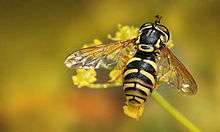Chrysotoxum cautum
| Chrysotoxum cautum | |
|---|---|
 | |
| Scientific classification | |
| Kingdom: | Animalia |
| Phylum: | Arthropoda |
| Class: | Insecta |
| Order: | Diptera |
| Family: | Syrphidae |
| Subfamily: | Syrphinae |
| Tribe: | Syrphini |
| Genus: | Chrysotoxum |
| Species: | C. cautum |
| Binomial name | |
| Chrysotoxum cautum (Harris, 1776) | |
| Synonyms | |
Chrysotoxum cautum is a species of hoverfly. It is found in southern Britain and Europe East into the Palearctic but is normally encountered in small numbers. The larvae are thought to feed on root aphids. Adults are usually found on the edges of woodland or scrub or along hedgerows where they visit a wide range of flowers.[1]
Identification
External images For terms see Morphology of Diptera
Wing length 10·25-13 mm.
Orange stigma.Apical antennomere as long as antennomeres 1 and 2 together.Abdomen relatively flat.The genitalia are exceptionally large and reach over the hind margin of sternite 4.
Keys and accounts
- Coe R.L. (1953) Syrphidae [2]
- Van Veen, M. (2004) Hoverflies of Northwest Europe [3]
- Van der Goot,V.S. (1981) De zweefvliegen van Noordwest - Europa en Europees Rusland, in het bijzonder van de Benelux[4]
- Bei-Bienko, G.Y. & Steyskal, G.C. (1988) Keys to USSR insects.Diptera [5]
Distribution
Europe [6] East across the Palearctic to Greece and Turkey and into Russia as far as the Altai mountains and Mongolia.
Biology
Habitat is deciduous forest and scrub, unimproved grassland and lightly grazed grassland , open areas in forest or scrub on well-drained sites.[7]Flowers visited include white umbellifers; yellow composites, Allium ursinum, Caltha,Cornus, Crataegus, Euphorbia, Geranium, Plantago, Ranunculus, Rhamnus catharticus, Rubus and Sorbus aucuparia.[8] The flight period is May to July (April in southern Europe).
References
- ↑ Stubbs, Alan E.; Falk, Steven J. (1983). British Hoverflies: An Illustrated Identification Guide. British Entomological & Natural History Society. pp. 253, xvpp.
- ↑ Coe, R.L. (1953) Diptera: Syrphidae. Handbks.ident.Br.insects, 10(1): 1-98. R.ent.Soc.London.pdf
- ↑ Van Veen, M. (2004) Hoverflies of Northwest Europe: identification keys to the Syrphidae. 256pp. KNNV Publishing, Utrecht.
- ↑ Van der Goot,V.S. (1981)De zweefvliegen van Noordwest - Europa en Europees Rusland, in het bijzonder van de Benelux. KNNV, Uitgave no.32: 275pp. Amsterdam.
- ↑ Bei-Bienko, G.Y. & Steyskal, G.C. (1988a) Keys to the Insects of the European Part of the USSR, Volume V: Diptera and Siphonaptera, Part I. Amerind Publishing Co., New Delhi. ISBN 81-205-0080-6.
- ↑ Fauna Europaea
- ↑ Speight, M.C.D. (2011). "Species accounts of European Syrphidae (Diptera)" (PDF). Syrph the Net, the database of European Syrphidae. 65: 285pp.
- ↑ de Buck, N. (1990) Bloembezoek en bestuivingsecologie van Zweefvliegen (Diptera, Syrphidae) in het bijzonder voor België. Doc.Trav. IRSNB, no.60, 1-167.